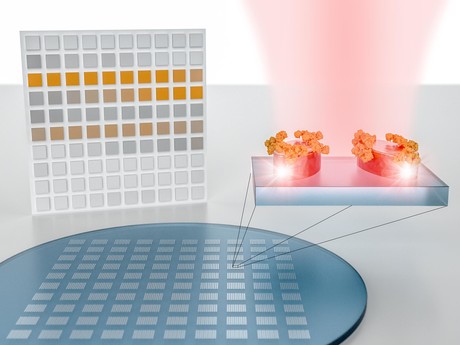Nanotech sensor turns 'molecular fingerprints' into barcodes

Researchers have developed a new system that can detect and analyse molecules with very high precision and without needing bulky equipment. Published in the journal Science, the research opens the door to large-scale, image-based detection of materials aided by artificial intelligence.
Infrared spectroscopy — the benchmark method for detecting and analysing organic compounds — requires complicated procedures and large, expensive instruments, making device miniaturisation challenging and hindering its use for some industrial and medical applications and for data collection out in the field, such as for measuring pollutant concentrations. Furthermore, it is fundamentally limited by low sensitivities and therefore requires large sample amounts.
Now, scientists at EPFL’s School of Engineering and the Australian National University (ANU) have developed a compact and sensitive nanophotonic system that can identify a molecule’s absorption characteristics without using conventional spectrometry. The scientists have already used their system, which is compatible with CMOS technology, to detect polymers, pesticides and organic compounds.
The chemical bonds in organic molecules each have a specific orientation and vibrational mode that influences the way molecules absorb light, giving each one a unique ‘signature’. Infrared spectroscopy detects whether a given molecule is present in a sample by seeing if the sample absorbs light rays at the molecule’s signature frequencies.
The EPFL system, on the other hand, consists of an engineered surface covered with hundreds of tiny sensors called metapixels, each of which resonates at a different frequency. When a molecule comes into contact with the surface, the way the molecule absorbs light changes the behaviour of all the metapixels it touches.
“Importantly, the metapixels are arranged in such a way that different vibrational frequencies are mapped to different areas on the surface,” said EPFL’s Andreas Tittl, lead author of the study. This creates a pixelated map of light absorption that can be translated into a molecular barcode — all without using a spectrometer.
“Thanks to our sensors’ unique optical properties, we can generate barcodes even with broadband light sources and detectors,” added Aleksandrs Leitis, a co-author on the study.
Unlike infrared spectroscopy, the system is both highly sensitive and capable of being miniaturised. Furthermore, the molecular barcodes can be massively analysed and classified using advanced pattern recognition and sorting technology such as artificial neural networks.
“The molecules we want to detect are nanometric in scale, so bridging this size gap is an essential step,” said Hatice Altug, head of EPFL’s Bionanophotonic Systems Laboratory and a co-author on the study.
There are a number of potential applications for this new system. ANU’s Dragomir Neshev, a co-author of the study, said, “For instance, it could be used to make portable medical testing devices that generate barcodes for each of the biomarkers found in a blood sample.”
Artificial intelligence could also be used in conjunction with the new technology to create and process a whole library of molecular barcodes for compounds ranging from protein and DNA to pesticides and polymers. That would give researchers a new tool for quickly and accurately spotting miniscule amounts of compounds present in complex samples.
A non-destructive way to locate microplastics in body tissue
Currently available analytical methods either destroy tissue in the body or do not allow...
Rapid imaging method shows how medicine moves beneath the skin
Researchers have developed a rapid imaging technique that allows them to visualise, within...
Fluorescent molecules glow in water, enhancing cell imaging
Researchers have developed a new family of fluorescent molecules that glow in a surprising way,...





